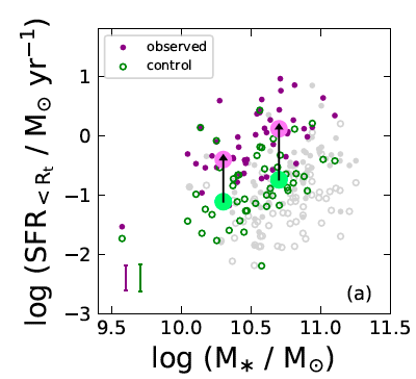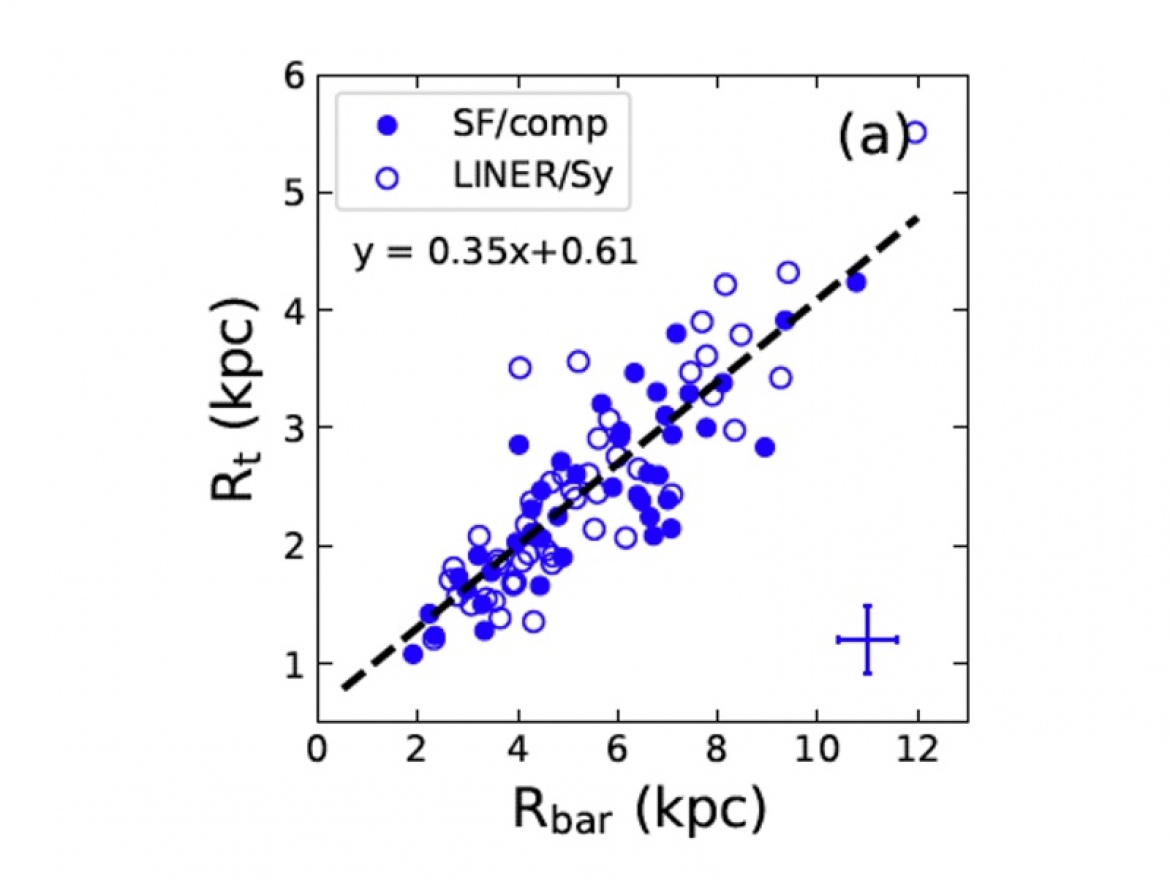Bars enhance the central star formation and gas inflow in nearby galaxies
Two thirds of spiral galaxies in the local Universe are observed to have a bar-shaped structure in their central region. Theoretically, galactic bars are expected to transfer angular moment from the center outwards through driving cold gas inward. As a result, the gas density at the galactic center will increase and thus trigger star formation, leading to the formation and growth of the central bulge. Therefore, galactic bars play important roles in the secular evolution of galaxies, through driving the inflow of cold gas, enhancing the central star formation, the consumption of cold gas, the growth of the (pseudo-)bulge, and probably that of the central super massive black hole as well. These processes have been seen in numerical simulations of disc galaxy evolution. Observationally, however, it is not easy to directly see the whole process due to the lack of suitable data. In recent years surveys of integral field spectroscopy such as CALIFA and MaNGA have obtained spatially resolved spectroscopy for large samples of galaxies at low redshifts, allowing the star formation history and stellar populations to be mapped across the whole galaxy. Meanwhile, mapping of cold gas content has also become available for a considerable number of galaxies at the same redshifts. These new data have enabled astronomers to study the role of bars in star formation and cold gas inflow in great detail.
A collaboration led by Prof. Cheng Li from the Department of Astronomy at Tsinghua University has carried out a series of studies on this topic, using data from both integral field spectroscopy surveys such as CALIFA and MaNGA and surveys of molecular gas emission line mapping such as CARMA-EDGE. The first paper of the series, led by Dr. Lin Lin from Shanghai Astronomical Observatory in collaboration with Prof. Cheng Li and others, found bars in the majority of galaxies with enhanced levels of central star formation (see Paper I in the reference list below). A follow-up paper led by Mr. Ryan Chown from McMaster University in collaboration with Prof. Cheng Li extended the work by jointly examining the CALIFA and the CARMA-EDGE data, finding that the central star formation, the bar structure, and the concentration of molecular gas are tied together (see Paper II in the reference list below, and also the Research Highlight of DoA at Tsinghua University available at http://astro.tsinghua.edu.cn/index.php/research/research-highlights/item/71-molecular-gas-concentration-driven-by-bars-and-interactions).
In a more recent paper led by Dr. Lin Lin from the Shanghai Astronomical Observatory, in collaboration with Prof. Cheng Li and the MaNGA team, the MaNGA sample is used to revisit the correlation of central star formation enhancements and bars. Thanks to the much larger sample size compared to the CALIFA sample used in previous papers, a tight and linear correlation is found between the size of the central region, where the star formation enhancement is seen, and the length of the bar (see the title picture above). The radius of the enhancement region is about 1/3 of the radius of the bar. A comparison of the star formation rate of the central region between the observed value and the value expected in the case of no enhancement indicates that the galaxies had their centers quenched some time ago, but have been rejuvenated recently due to the bar-driven star formation enhancement (see Fig.1 below). In fact, not only the star formation, but also many other properties are modified by the bar-driven processes, as can be seen from Fig.2. These studies have provided evidence in support of the picture in which galactic bars play crucial roles in galaxy evolution. Even larger samples and comparison with realistic simulations of galaxy formation would be needed in order to have a more complete picture of bar-driven evolution of galaxies.
Relevant publications:
Paper I: Lin Lin, Cheng Li, Yanqin He et al. 2017, ApJ, 838, 105 (https://arxiv.org/abs/1609.05287)
Paper II: Ryan Chown, Cheng Li, E. Athanassoula et al., 2019, MNRAS, 484, 5192 (https://arxiv.org/abs/1810.08624)
Paper III: Lin Lin, Cheng Li, Cheng Du et al., 2020, submitted to MNRAS (https://arxiv.org/abs/2005.09853)





